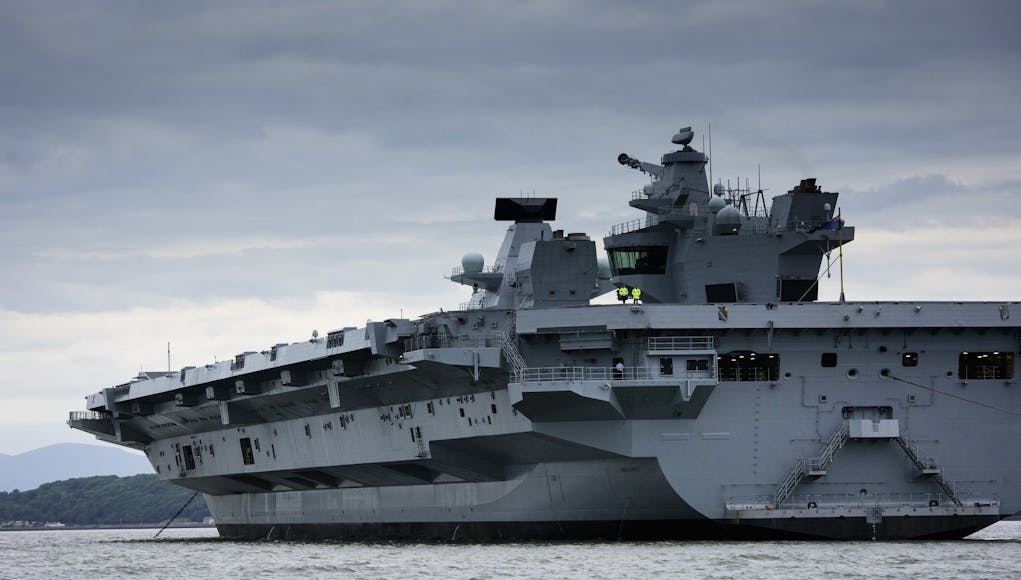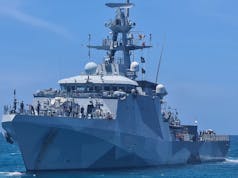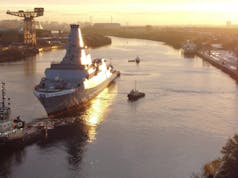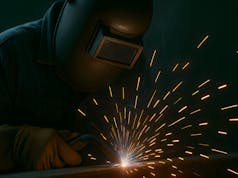Defence Secretary Michael Fallon has mocked Russia over fears it will attempt to spy on HMS Queen Elizabeth during sea trials.
Writing in the Telegraph, Fallon said:
“It’s really routine for the Russians to collect intelligence on our ships. We will take every precaution to make sure that they don’t get too close, but I think they will be admiring her.”
He added: “When you saw that old, dilapidated Kuznetsov sailing through the Channel, a few months ago, I think the Russians will look at this ship with a little bit of envy.”
The smaller Russian Kutnetsov has been plagued by technical problems and is accompanied by a tug when she sails.
The Russian carrier is designed to lead a flotilla of vessels or operate solo while keeping enemy fleet at bay using its anti-ship missiles and using its aircraft to deter enemy aircraft.
The Queen Elizabeth class are designed to operate with a battle group to maintain air superiority, strike a variety of strategic and tactical targets using aircraft in addition to providing an air assault platform.
Despite recent sensationalist tabloid headlines, describing the Admiral Kuznetsov as “massive” while decrying the UK’s “tiny ships”, the Queen Elizabeth class are of a significantly higher tonnage than the Russian vessel, each sitting at 70,600 tonnes compared to its 55,000.
That being said, size is a poor indicator of carrier capability so let’s look beyond tabloid headlines.
What are the basics?
The Queen Elizabeth Class aircraft carriers will be the largest surface warships ever constructed for the Royal Navy.
The vessels will be utilised by all three branches of the UK Armed Forces and will provide eight acres of sovereign territory. Both ships will be versatile enough to be used for operations ranging from high intensity conflict to providing humanitarian aid and disaster relief.
Surprisingly for their sheer scale each ship will only have a total crew of 679, only increasing to the full complement of 1,600 when the air elements are embarked. This is made possible by extensive automation of many systems.
HMS Queen Elizabeth, the first in a fleet of two, is currently in the final stages of completion, the vessel is due to go sea for trials after the New Year.
The Admiral Kuznetsov serves as the flagship of the Russian Navy and is their only aircraft carrier. The initial name of the ship was Riga; she was launched as Leonid Brezhnev in 1985.
She was originally commissioned in the Soviet Navy and was intended to be the lead ship of her class but the only other ship of her class, Varyag, was never completed or commissioned by the Soviet, Russian or Ukrainian navy. This second hull was eventually sold to the People’s Republic of China by Ukraine, completed in Dalian and launched as Liaoning.
The Russian vessel carries a number of offensive weapons typically associated with guided missile cruisers and the carrier itself is capable of engaging surface, subsurface and airborne targets.
What kind of power can they project?
The Queen Elizabeth class carriers, in peacetime, will usually deploy with around 24 F-35Bs and typically around 14 helicopters. The exact types and numbers of aircraft embarked being adjusted to meet current requirements and threats.
In addition to the joint force of Royal Air Force and Royal Navy F-35Bs, the air wing is expected to be composed of a ‘Maritime Force Protection’ package of 9 anti-submarine Merlin HM2 and four or five Merlin for airborne early warning; alternatively a ‘Littoral Manoeuvre’ package could include a mix of RAF Chinooks, Army Apaches, Merlin HC4 and Wildcat.
The vessels are capable of deploying a variety of aircraft in large numbers, up to a maximum in the upper fifties in surge conditions.
The Queen Elizabeth class mark a change from expressing carrier power in terms of number of aircraft carried, to the number of sortie’s that can be generated from the deck. The class is estimated to be able to sustain a maximum sortie generation rate in surge conditions of up to 110 sorties per day.
The Admiral Kuznetsov can hold up to about 40 fixed-wing aircraft and helicopters, including Su-33 fighters and various versions of Ka-27 helicopter, however it rarely sails with more than half of that number.
While designated an aircraft carrier by the West, the design of Admiral Kuznetsov implies a mission different from that of either the United States Navy carriers or those of the Royal Navy.
The Admiral Kuznetsov is a heavy aviation cruiser rather than just an aircraft carrier. The vessel carries a number of offensive weapons typically associated with missile cruisers. The carrier itself is capable of engaging surface, subsurface and airborne targets, independently of its air wing.
According to War is Boring here:
“Admiral Kuznetsov has never seen combat, nor would she be of much practical military use. The 55,000-ton carrier has a bow ramp, not steam catapults, requiring her aircraft to shed weight before taking off.
This means her planes will go into combat with less fuel or bombs than the ground-based fighters Russia has already deployed to Syria.”
During the voyage the Admiral Kuznetsov reportedly “will have about 15 fighters Su-33 and MiG-29K/KUB and more than ten helicopters Ka-52K, Ka-27 and Ka-31”.
STOBAR (Short Take-Off But Arrested Recovery), the system used for the launch and recovery of aircraft from the Admiral Kuznetsov, does not allow for the same frequency of launches/recoveries and tempo of operations afforded by American carriers or even the Queen Elizabeth class.
With Short Take-Off But Arrested Recovery, the aircraft take off using the ramp and are arrested by a cable when landing back on the deck. This means that the Admiral Kuznetsov’s aircraft will only be able to fly a relatively limited number of sorties daily.
Other relevant factors include the process and capacities for transporting ordnance to assembly areas and from there to the flight deck, refuelling and arming stations layout, number and capacities of aircraft elevators, etc.
Conclusion
These vessels clearly cannot do some of what the other can, while the Admiral Kuznetsov can venture alone at times, the Queen Elizabeth would be unable due to a lack of offensive capabilities.
These vessels although similar in overall form are designed for different roles and with different ideologies in mind. The topic of which ideology is more practical today however is an entirely different topic.
As an aviation platform however, the Queen Elizabeth class will certainly be more capable and in the role of a cruiser, the Admiral Kuznetsov clearly comes out on top.
Is the press right to portray the Kuznetsov as something akin to the Bismarck however? No, clearly not.
The Russian flagship while a potent symbol is heavily outdated and its mix of roles, cruiser and carrier, severely restricts its capabilities in the mission has been deployed for off Syria.
It shouldn’t come as a surprise that the more modern Queen Elizabeth class vessels will be far more capable aviation platforms.













Russia have never had any real navel power .. Our ships and sub’s are fast being modernized..
When them F35 or on it next year the only 5 th generation fighter on the planet and the Apache it can do what it wants and nobody can do anything about it ..
[…] UK Defence Journal, By George Allison, June 27, 2017 […]
This seems to be a bit of tabloid news “Admiral Kuznetsov has never seen combat, nor would she be of much practical military use. The 55,000-ton carrier has a bow ramp, not steam catapults, requiring her aircraft to shed weight before taking off. I think all this applies to QE II she has NO self defence weapons No angled flight deck. On an angled deck, in the event of a waveoff or a “bolter” (failure of the tailhook to snag a wire) the pilot added power and went around for another approach. Flight deck operations could continue without interruption. I know that F35B has not got this problem of miSsing the wire but QEII should have had a angled deck and also the F35B will have to shed weight on landing i.e ditch ordance i really canot see QEII being able to carry out 110 sorties per day with one run way and landing deck
They will not have to ditch weapons in order to land!
Firstly, the UK doesn’t have much in the way of heavy weapons.
The Paveway IV will be as big as it gets.
Secondly, fully laden takeoff is around 600ft….. with 8 tonnes of fuel.
There will be no issue landing with weapons after a sortie on a 900ft runway.
The Russians are operating conventional jets of their ski-ramp-and-no-cats carrier whereas we will have the F-35B’s lift fan and downward vectoring of the main engine to boost lift in the takeoff phase and also to use to cushion the landing in the worst-case rolling short landing that the RN/RAF has developed and simulated for the times when a returning plane does need to land with a particularly heavy load. Ditching weapons in order to land should be a thing of the past (the Harrier days) now.
Ultimately I assume the F-35Bs will potentially have heavier stuff than Paveway IV, perhaps in the medium term the Kongsberg JSM (here’s hoping!) which is about twice the weight of Paveway iV and ultimately maybe Spear 5 (Storm Shadow replacement and something which presumably will be integrated with F-35B). With Storm Shadow due to go out of service about 2030 I think and with possible delays it could even stretch to 15 – 20 years from now until Spear 5 is available so who knows what the situation will be then. Higher thrust F-35B engines and fully worked out carrier ops particularly the rolling landings might even make that retrievable.
Her name is Hms Queen Elizabeth not QEII. The QEII was a cruise ship.
You need to get your information correct as you cant compare the QEII to a Russian Aircraft Carrier!!!
When the F35 and Apache are on board next year it will be able to do what it wants when it wants
Mr Fallon needs to grow up and take his head out of the sand. I’m afraid that successive governments have decimated the armed forces, and once this ship is out in the deep crystal waters will be easy prey.
Don’t forget Mr Fallon that we currently have the latest Type 45 that breaks down, an army that could fit inside Wembley stadium with plenty of room and an airforce without maritime protection. Just explain to me who is really laughing when you do not have sufficient Navy personnel to man these ships!!!
Having proudly served in the forces, I am both depressed and disheartened to see the demise of our forces and the lack of interest shown by politicians in truly understanding what loyalty truly means.
Just to make you feel better Paul,
If the 2007 aid budget had the same 28% austerity cut as defence, police, fire etc that would free enough money for three new QE Carriers every year :-/
Still, this one is a beauty
I am a bit of a defence enthusiast and usually enjoy your articles but you really are becoming awfully fawning, we may as well be reading the MOD official blog.
You seem scared to criticise or question anything you are being fed by the MOD – you need to be more than a government mouthpiece if you want to maintain any credibility.
A few factual errors in this piece. Example: you link to a Sun piece with the anchor text ‘tiny ships’, when the article actually speaks about a tiny navy – not the same.
What a sad, pathetic little man.
The Russians would love to have two brand new carriers like the QE.
While the Russians like to posture they have no effective conventional military capability beyond their own backyard.
With the price of oil heading down again that is not going to change.
Why is it?
I’m sure Russia wouldn’t mind a new carrier but they have stated their priority is being a regional land power and so a carrier does not fit their military planning and so would take money away from where they feel it is needed.
Whether the UK should have spent the money elsewhere is up for debate in my opinion. Only time will tell if it was really needed or just a white elephant / status symbol.
If we could wind the clock much of our defence procurement would be changed to be more affordable and more capable.
T45s with a LM2500 powerplant, SM2/3 missiles and the APAR radar system for system for starters. But we are where are were we are and have to make the best of it.
The frustrating thing for me is we seem to make the same mistakes with defence procurement over and over again. We spend our limited financial resources very badly, I see the warrior upgrade is in trouble as the contractor struggles with the cost and complexity of the project.
Keep it simple stupid springs to mind.
QE is a superb ship. However there are some glaring problems with our armed forces currently due in no small way to successive conservative governments and their mantra of cut, cut cut.
we have currently NO maritime patrol aircraft. This is not going to be resolved until 2019 (when we get wait for it the first 2 of 9 poseidons ordered) full fleet of 9 MPAs not available until 2021-2022
our type 45 destroyers urgently need their propulsion problems resolved and at the same time a 24 cell mk41 vl cell fitted.
The royal navy has inadequate numbers of frigates, destroyers and submarines to provide a carrier battle group.
The defence select committee have said on record that 26 high-end escort warships and over 8 ideally 9 SSNs is what we need as a minimum to meet force commitments (in peacetime)
In 2018 we will have no lph as HMS ocean being sold off early, despite a £65 million refit supposed to keep her in service until 2023. Instead we are told we can use one of our brand new £3 billion strike carriers as a landing ship. Utter madness! £3 billion vs 400-600 million to build a suitable replacement for Ocean.
The RAF/ RN has no repeat no antiship missile and uk will be only major Nato or world power unable to sink enemy warships. Better order Norwegian antiship missile asap (before harpoon goes out of service without replacement)
I do not think the Russians are envious. I would imagine they are laughing their socks off at the gaping holes in our national defences, thanks to conservatives and their package of austerity and cutbacks.
Most of our current problems lay with the Labour governments of 1997 to 2010 and it’s inadequate funding of the military during the Iraq and Helmand operations.
Huge mistakes were made in that period.
The problem I have with the current government is that they are not learning from those mistakes.
So a curse all their houses.
Indeed. It as much a case of inadequate leadership at star officer level as it is a case of the MOD being in hock to BAe for everything. In addition to woeful project management and all of the other factors that we’ve known about for years and never corrected.
I am sure the Russians would love two 70,000 ton carriers but they would have even more problems than us using them. Mr Bell is right the RN have several current and looming problems. The really sad part is that they are all fixable with a little more money and imagination. For instance the target of 24-27 escorts could be attained by increasing the Type 26 order to 9 hulls delivered by mid 2030s at which time the Clyde yard switches straight on to Type 45 replacement and we build 9 of them (the 4rth would replace the 1st Type 45). Build the Type 31 concurrently with Type 26 using the CVF method (blocks from several yards assembled at one location) and build 9 of them. Problem solved. Admittedly not until around 2040 but better late than never. In he meantime fit the 16 MK41 vls to Type 45 at the same time as the engine upgrades and make a small purchase of NSM while we wait on LRASM (which long term will replace Harpoon & Tomahawk). In regard to HMS Ocean, yes it’s insane to expect the carrier to do her job but equally we don’t need a new purpose built ship to carry troops and helos. It seems unlikely that we will deploy large scale ground forces anytime soon so with that in mind why not convert 2 of the 4 Point class RoRos to replace Ocean. Seal up the stern, extend the superstructure aft of the bridge and use this space (and space below bridge currently) as a hanger for several Merlin (maybe 4-6?). Then fill the entire hull with modular berthing. We should be able to squeeze 500/600 troops in that space. Yes the helo capacity is way down on Ocean but the carrier can house extra as can the FSS ships when they arrive. There is a very good article covering the possible conversion of the Point class on Think Defence.
The number of escorts discussion is an interesting one, but there is another angle to this. If the UK is operating two carriers on its ownsome, then indeed it needs a full complement of escorts for either each operating independently, or for the two in tandem. Plus others to do other jobs, and following the rule of active / resting / transit / refit or repair.
But if the UK is more interested in providing carriers for some sort of joint operations, within NATO, or with European fleets. then it can rely on escorts from other countries, in the same way as the UK has provided escort(s) for the C de G, and I think the Yanks.
So the current small number of escorts and the building program for the T26, is not neccessarily a problem at all, specially over the next 10 years when you could hope that Brexit will leave defence co-operation unaffected.
Morning dadsarmy 🙂
I suspect NATO allies will indeed contribute especially on exercise but my issue is at some point we usually end up alone surrounded by this fabulous moat across which survival depends.
Being on our own looks much less ridiculous now than in did two years ago and that moat has always been awfully big.
Part of my post Brexit strategy would be to focus investment on security of the nation; defence, police, energy, food, transport, borders etc but is not to be 🙁
I agree about the moat, and the UK being a realtively small island / group of islands surrounded by water really does need a stronger navy than average.
But there should be time to build up, QE 2020 ready for emergency deplyment, 2023, fully ready, after that more F35-Bs, hopefully complemented by RAF ones. Then by 2030 a few T26s ready, and build up from there.
The biggest mistake in my opinion is cutting T45 at 6, should have been 8. And Astute needs a boost.
Frigates as in the T31 can be relatively easy and cheap, and bought off the shelf as it were, something I suspect the UK will start doing within the decade.
Or in reply to David Stephens comment purchase a couple of large but cheap container ships, like Atlantic Conveyor but bigger, with more modern codad engines. They should be good for sustained speed of 17-21 knots (faster than Ocean). I would fully convert them to lph role so stern and side ramps, mexi floats, stern small dock area, flat top as a helicopter carrier, fit new sensors, radar and comms. Self defence weapons= containerised sea ceptor, 3-4 phalanx/ sea RAM, Italian anti torpedo/ anti mine rockets and a splattering of 20+30mm guns. A 38-48,000 ton container ship could be a cheap solution. There is a glut of ships of this size in the world as all major shipping companies are moving upto the vast modern container ships of 80,000 tons + capacity. If a container ship conversion was performed to a high enough standard, it could deliver strategic life of 1000-1500 troops.
How petty.
All blame the government, pass and present but where were the so called senior officers when this was going on. Hiding to keep their pensions and titles safe. Only fundamental reform from the top down will bring the changes needed.
I don’t really see the point in comparing the QE with the Kuznetsov. She has a different mission even, being as said capable of standalone, though usually accompanied by a missile cruiser. Whereas as also stated the QE is as part of a carrier group providing protection though with of course the QE having final defence CIWS. And clearly though status symbols as well as being useful, the Russians haven’t and don’t prioritise carriers, that being perhaps for subs and aircraft.
I’d prefer a comparison with the Nimitz, and a sensible comparison of the QE’s VSTOL compared with CATOBAR – but in terms of different theatres of operations (Med/Gulf/Arctic v Pacific) and perhaps different needs of flexibility in the future – and perhaps even interoperability with the US potential future light VSTOL carriers.
I do not think they(Russians) are jealous of an aircraft carrier that will have no fixed wing element
for the next several years.
I think he (Fallon) needs to stop talking like a child in the playground and more like a politician.